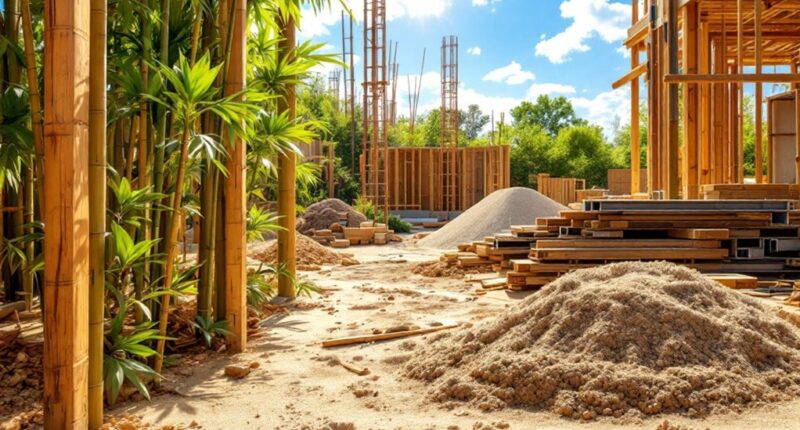Sustainable construction materials are revolutionizing how we build. Think of bamboo, a speedy green superhero, or hempcrete, the cozy insulating wonder! Then there’s mycelium, the fungus that’s not just for pizza anymore; it’s fire and water-resistant too! These low-carbon champions drastically reduce the environmental toll of building. And don’t forget about recycled steel or reclaimed wood, which add charm while being planet-friendly. Curious about what else is changing the game? There’s more to discover!

In the ever-evolving world of construction, where the quest for sustainability is as hot as a summer sidewalk, an array of innovative materials and low-carbon building practices are stepping into the spotlight. The construction industry is showing its green side, trading in traditional concrete and steel for a treasure trove of eco-friendly substitutes. Picture bamboo, the superhero of plants, growing faster than gossip at a family reunion. Strong yet renewable, it’s a favorite among builders looking to lighten their carbon footprint. Bamboo’s rapid growth and renewable nature help reduce environmental impact compared to traditional wood.
Hempcrete, a curious blend of hemp stalks, lime, and water, is swiftly gaining traction for its insulating properties, making it as cozy as your grandma’s knitted sweater. Meanwhile, mycelium—the fungal underdog—offers a biodegradable alternative that’s fire and water-resistant. It’s like nature’s version of a Swiss Army knife, ready for any challenge. And let’s not forget mass timber, which is stepping up as a viable alternative to steel and concrete, proving that wood is not just for treehouses.
Recycled and reclaimed materials are also making waves. Recycled steel, infinitely recyclable, helps reduce the need for virgin materials, while reclaimed wood adds a touch of character that new lumber simply can’t match—think of it as the vintage wine of building materials. Even plastic waste is getting a makeover, as recycled plastic finds new life in construction.
Concrete alternatives are likewise in the limelight. Low-carbon cement replaces up to 50% of its traditional counterpart with supplementary cementitious materials (SCMs), while bendable concrete, known as engineered cementitious composite, boasts an impressive resistance to cracking—500 times more than the conventional stuff! Using additives in concrete can also significantly reduce its carbon footprint, making it a crucial component of sustainable construction.
As construction embraces these sustainable materials and practices, it becomes clear that the industry is not just building structures—it’s building a greener tomorrow. With each low-carbon choice, builders are redefining what it means to go green, proving that the future of construction can be both innovative and eco-friendly.
Frequently Asked Questions
What Are the Benefits of Using Recycled Materials in Construction?
Using recycled materials in construction offers a plethora of benefits. It substantially reduces waste, cutting landfill contributions by up to 59%, and conserves natural resources, creating a win-win for both the planet and the wallet.
Economically, it slashes material costs by about 25%, while enhancing performance with durable options like reclaimed wood and concrete. Plus, it boosts local economies and improves indoor air quality, proving that being green can also be smart and stylish.
How Do Low-Carbon Materials Affect Building Costs?
Low-carbon materials can substantially influence building costs, often offering savings that surprise many. While there may be a slight upfront premium, these materials reduce embodied carbon by 19-46%, making them an eco-friendly option.
Over time, energy-efficient features could cut utility bills by up to 25%. It’s like investing in a quality pair of shoes—initially pricier, but they last longer and save money on replacements. Ultimately, the financial benefits stack up, creating a win-win scenario.
Are There Certifications for Sustainable Construction Materials?
When it comes to sustainable construction materials, certifications are like badges of honor. Think of them as the gold stars teachers give out, but for eco-friendly building.
Certifications like LEED and BREEAM verify a material’s green credentials, ensuring it meets environmental standards. These badges not only boost a building’s credibility but can also enhance its market value, making it a win-win for the planet and the wallet. Who wouldn’t want a certified green fortress?
What Is the Lifespan of Low-Carbon Building Materials?
When it comes to low-carbon building materials, lifespan varies widely. For instance, timber can last over a century with care, while mycelium insulation, the quirky fungus-based option, holds on for 20-30 years.
Hempcrete, the eco-champion, might stick around indefinitely Meanwhile, recycled steel and carbon-negative concrete boast lifespans similar to traditional materials. Think of it as a durability race, where maintenance and environmental factors play the ultimate game-changers, deciding who lasts the longest.
How Can Homeowners Incorporate Sustainable Materials in Renovations?
Homeowners can easily weave sustainable materials into their renovations like a talented chef blending flavors. They might opt for bamboo flooring—fast-growing and tough, or choose reclaimed wood for a unique, eco-friendly twist.
Energy-efficient appliances and LED lighting can turn a kitchen into an energy-saving superstar. Even small touches, like low-VOC finishes, can spice up indoor air quality. It’s all about making choices that are kind to the planet while keeping style in mind









